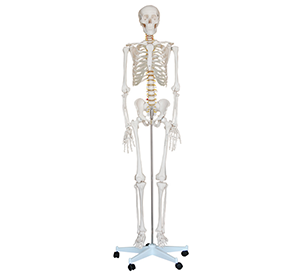ADA MED SUPPLY LIMITED
Phone:+86 19937901373
Tel:+86-0379-65160607
Email:adaanatomy@adaanatomy.com

Article tag: 180 Human Skeleton Model BIX-A1001 Human skeleton model

Clinical significance
180 The application of human skeletal models in medical education, especially in anatomy and clinical skills training, is of great significance. As the foundation of the medical profession, the skeletal system is the part that students must have a deep understanding of, and mastering bone structure and function is essential for the diagnosis and treatment of bone-related diseases. Through the high-precision 180 human bone model, students can more intuitively and comprehensively understand the bone shape, position, joint structure, etc., which is helpful to improve its application ability in clinical practice, especially in orthopedics, emergency departments and other departments.

Personal growth
For medical students, mastering anatomy knowledge is a basic requirement for entering the clinic. Through the study of 180 human bone models, students can strengthen the spatial perception of human bones and understand the anatomical characteristics of different bones and joints. This intuitive way of learning helps students more accurately locate the lesion site or intraoperative operation in future clinical operations, reduce surgical errors, and improve personal professional abilities. In addition, the multi-angle and detachable design of the model can help students flexibly grasp the various details of the skeletal system, and further promote the accumulation of students' knowledge and the cultivation of clinical thinking.
Industry expert views
Many industry experts emphasize that anatomy is a cornerstone of medical education, and the application of models is an important means to enhance education. Experts believe that the 180 human skeleton model, with its highly reductive design, can enable students to practice repeatedly without a real corpse and become familiar with the structure and function of human bones. In addition, the operability of the model enables students to complete various anatomical operations independently, thus improving the confidence and proficiency of the operation. Experts generally believe that with the development of medical education, simulation training has gradually become an effective way to improve clinical skills and anatomical knowledge.
Data support
Research data showed that students who learned using high-precision anatomical models performed significantly better in clinical practice than students who learned in traditional ways. In a study of 200 medical students, those trained on 180 models of human bones scored 30 percent higher on anatomy exams and made significantly fewer errors in simulated and actual procedures. The data also showed that these students became more adept at identifying and managing fractures and dislocations during clinical operations in orthopedics and emergency departments, indicating that the model training significantly helped in practical operations.
Conclusion
180 The introduction of the human skeleton model has significantly improved students' understanding of anatomy knowledge and application ability in clinical practice. Through this efficient and intuitive teaching tool, students will not only be able to deepen their understanding of the skeletal system, but will also be able to reduce errors and improve manipulation accuracy in future clinical practice. The wide application of this model is expected to become a routine training tool in medical education in the future, helping students better move from basic knowledge to clinical practice.